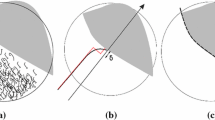Abstract
We construct anisotropoviscous two- and three-layer models of the effect of reduction of hydrodynamic resistance through the addition of polymers. The three-layer model can be used to compute the hydrodynamic resistance of turbulent flows with polymer additives in the entire region of variation of the Reynolds numbers, and the two-dimensional model can be used with large Reynolds numbers. Two figures. Bibliography: 3 titles.
Similar content being viewed by others
Literature Cited
A. B. Stupin, “A semiempirical theory of the effect of reduction of turbulent friction through polymer additives,”Mekh. Neodnorod. Turbul. Potok., 45–52 (1989).
A. S. Monin and A. M. Yaglom,Statistical Hydromechanics [in Russian], St. Petersburg (1992).
L. G. Loitsyanskii,Fluid and Gas Mechanics [in Russian], Moscow (1978).
Additional information
Translated fromTeoreticheskaya i Prikladnaya Mekhanika, No. 26, 1996, pp. 135–141
Rights and permissions
About this article
Cite this article
Bykovskaya, N.V., Stupin, A.B. Anisotropoviscous models of the phenomenon of reduction of hydrodynamic resistance. J Math Sci 86, 3172–3175 (1997). https://doi.org/10.1007/BF02355721
Received:
Issue Date:
DOI: https://doi.org/10.1007/BF02355721




